The Task Scheduler is a built-in utility that allows you to create, run, and schedule tasks. However, we have noticed that when trying to perform any task using the Task Scheduler, an error pops up, signifying that we lack the required permission. So, if there is no permission to disable, create, run, or change Task Scheduler task, you need to follow the solutions mentioned here.
No permission to disable, create, run or change Task Scheduler task
If you do not have permission to disable, create, run, or change Task Scheduler task in Windows 11/10, follow the solutions mentioned below.
- Start the Task Scheduler as an administrator
- Check if the user has full control of the task
- Check the status of the Task Scheduler service
- Troubleshoot in Clean Boot
- Recreate the task
Let us talk about them in detail.
1] Start the Task Scheduler as an administrator
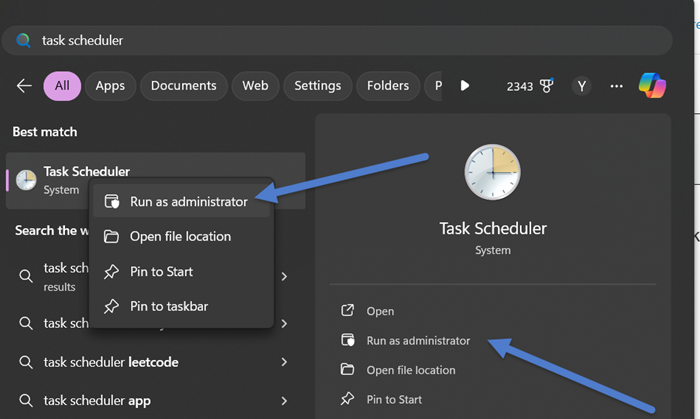
At times, the Task Scheduler needs you to have admin privilege to make any changes to the tasks. And we suspect that is exactly what’s happening here. So, go ahead and launch the Task Scheduler with admin rights. To do so, search out “Task Scheduler” from the Start Menu, right-click on it, and select Run as administrator. Click “Yes” when the UAC prompt appears. Now, see if you can alter the task.
2] Check if the user has full control over the task
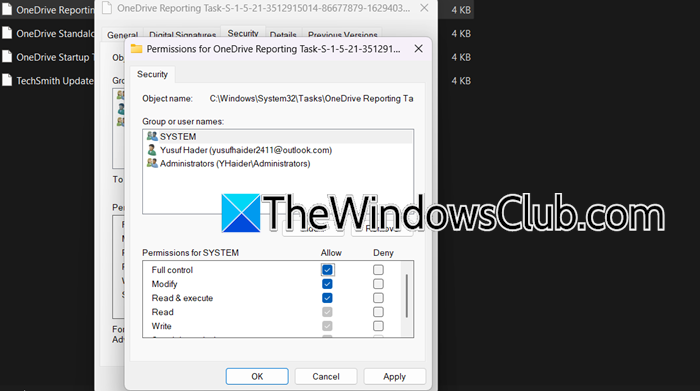
To resolve issues with the Task Scheduler, ensure the user has full control over the task. Check the task’s permissions in its properties and verify that the user’s account has the necessary access rights. This ensures that the user can modify, run, or disable the task without restrictions. To do so, you can follow the steps mentioned below.
- Open the File Explorer and go to C:\Windows\System32\Tasks, which is the default location of all the tasks.
- You may be asked to confirm if you have permission to access the folder, as it is a system folder, acknowledge and move on.
- Now, look for the task that you are unable to alter; it can be under some folder. Right-click on the task and select Properties.
- Go to the Security tab, select your username, and click on Edit.
- Now, allow Full Control, and click on Apply > Ok.
Finally, open the Task Manager and see if you are able to make changes to the task now. Most probably, this will do the job.
3] Check the status of the Task Scheduler service
If you want to run the Task Scheduler, the Task Scheduler service must be configured correctly. To do so, follow the steps mentioned below.
- In the Services.msc app, look for Task Scheduler.
- Right-click on it and select Properties.
- Now, check and ensure that the Startup type is set to Automatic and the service is running.
If you have made any changes, make sure to click on Apply > Ok to confirm the changes.
4] Troubleshoot in Clean Boot
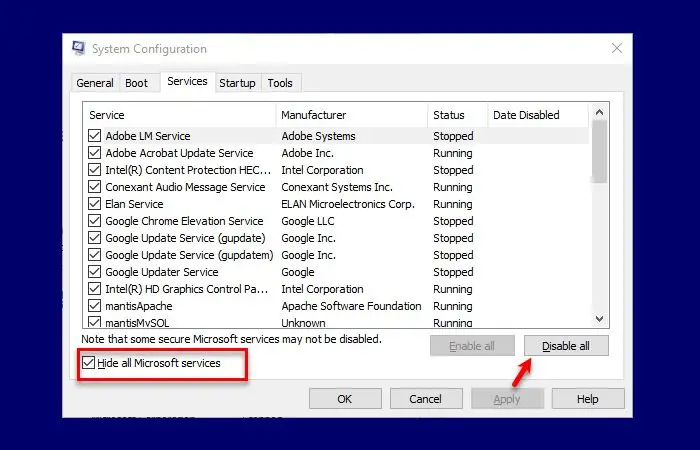
If you are unable to make any changes or create a task in the Task Scheduler, there is a possibility that a third-party service is interfering with the functioning of the Task Scheduler. In order to investigate further, we need to start your computer in the Clean Boot state. Now, open the Task Scheduler and see if you are able to make any changes. If it works, you need to enable services manually to find out if the issue is resolved.
5] Recreate the task
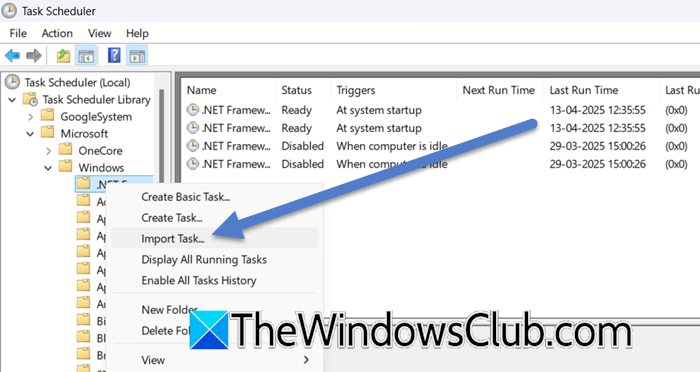
If there is a specific task that you are facing issues with, we would have to recreate it. We don’t have to create the task from scratch; instead, we can export the task into an XML file and then import it. To do so, you can follow the steps mentioned below.
- Open the Task Scheduler by searching for it in the Start Menu and locate the faulty task.
- Now, right-click on the task and select Export.
- Navigate to the location where you want to store the file and save it in the XML format.
- Now, right-click on the parent folder and select Import Task.
- Go to the location where you have stored the task and select it.
Once the task is imported, you need to check if the issue is resolved.
Hopefully, with the help of these solutions, you will be able to resolve this issue.
The user account you are operating under does not have permission to disable this task
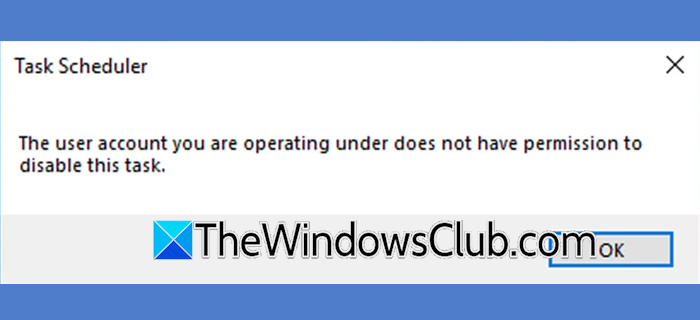
Task Scheduler: The user account you are operating under does not have permission to disable this task.
If you don’t have permission to disable a task, check if your user has control over the task. You can look for the task at C:\Windows\System32\Tasks and then alter its properties to gain control. We recommend you follow the solutions mentioned earlier to do the same. If this doesn’t work, you can download and use the PsTools from learn.microsoft.com to disable the task. Now, extract PSTools to a folder on your desktop, then open Command Prompt as Administrator and navigate to the PSTools directory using cd c:\user\<username>\Desktop\PsTools. Run the command psexec -i -s %windir%\system32\mmc.exe /s taskschd.ms which provides elevated permissions. Finally, locate the problematic task in Task Scheduler, right-click it, and select Disable to resolve the issue.
This task requires that the user account specified has log on as batch job rights
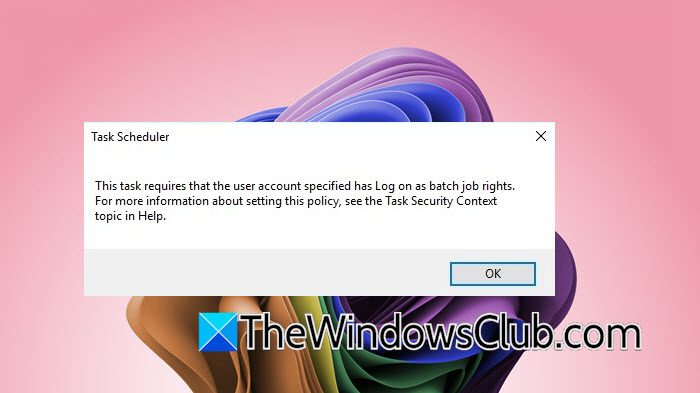
This task requires that the user account specified has Log on as batch job rights. For more information about setting this policy, see the Task Security Context topic in Help.
You will encounter this issue if you don’t have access to log on as a batch job. To resolve this issue, open Local Security Policy via the Start menu, navigate to Security Settings > Local Policies > User Rights Assignment, and locate Log on as a batch job. Add the required user account, save changes, and restart the computer to apply the updated permissions. This ensures the account can run tasks requiring batch job rights.
Task Scheduler cannot apply your changes
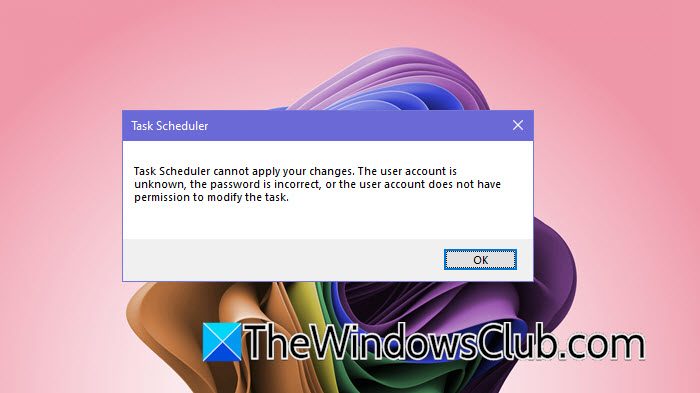
Task Scheduler cannot apply your changes. The user account is unknown, the password is incorrect, or the user account does not have permission to modify the task.
To resolve this issue, ensure the user account is valid and has the correct password. Additionally, verify that the account has administrative privileges and full control over the task folder in C:\Windows\System32\Tasks. If the issue persists, recreate the task by exporting it as an XML file, deleting the original task, and reimporting it with updated credentials. You can check out the solutions mentioned earlier to know more.
Read: How to delete Scheduled Task in Windows
The user account does not have permission to view task history on this computer
To resolve this, ensure your account has administrative privileges. Navigate to C:\Windows\System32\Tasks, right-click the folder, go to Properties > Security, and grant your account full control. Restart Task Scheduler or your system to apply the changes and view task history. Additionally, follow the other solutions mentioned in this post.
Also Read: The specified account name is not valid Task Scheduler Error.
Leave a Reply